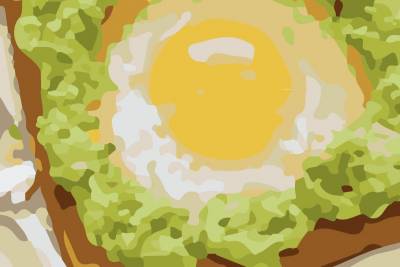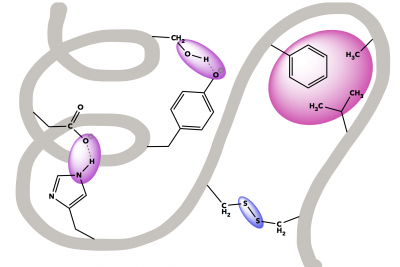Experiment with Fermentation using Kombucha
Background
Kombucha, which comes from Japan, is possibly completely misnamed as kombucha refers to tea from kombu (kelp) rather than a fermented tea beverage (which has another name in Japanese)—nevertheless it stuck, and seems to be here to stay. The kombucha live ferment also goes by several names: SCOBY (symbiotic colony/culture of bacteria and yeast), mushroom, mother, or pellicle (the scientific term).
Kombucha is made from tea (often green or black) and sugar (often refined table sugar, but other sugar sources such as maple sugar/syrup can be used so long as they still provide glucose and fructose to the culture) mixed with a small amount of active culture (SCOBY disc and/or liquid culture). This is left to ferment for around one – two weeks, after which time it can be moved to a bottle, mixed with added sugar and flavor sources, and sealed in order to carbonate the final beverage over the course of another few days.
SCOBYs vary in physical appearance and DNA analysis of the microbes present suggests variation in genera and species between different cultures. The yeast component is mostly Zygosaccharomyces—a wild yeast that tolerates high concentrations of alcohol, low pH, and other often-limiting environmental conditions—and this seems to be mostly stable between different cultures. The bacterial component shows more variation, including representation from Acetobacter and Gluconacetobacter—to turn ethanol into acetic acid (giving the sour, vinegar flavor)—as well as Lactobacillus—lactic acid-producing bacteria—in some instances. These are all genera and the specific species present definitely vary between cultures. It is not yet clear how dependent particular species are on one another and is the subject of current laboratory research.
The yeast is responsible for turning the initial sugar into ethanol and carbon dioxide, while the bacteria turn the ethanol into acetic acid. Initial studies suggest that the yeast is responsible for colony formation, while the bacteria secretes the cellulose matrix to produce the microbial mat or biofilm (often referred to as the SCOBY) that keeps the organisms organized and floating at the surface of of the fermenting tea.
Materials
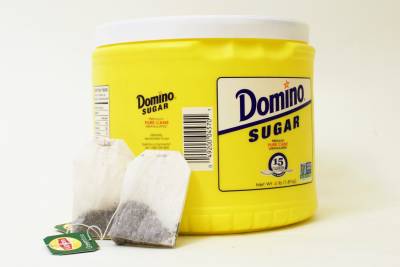
Corner Store: Grocery Items
- Green or Black Tea Bags
- Table Sugar (Sucrose)
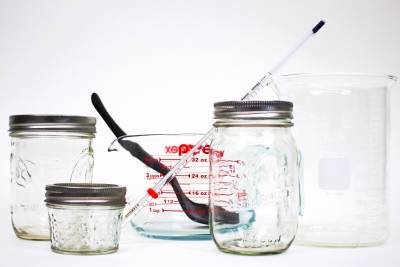
Corner Store: Kitchen Items
- Spoons
- Jars (with loose covers)
- 1L measuring cup or beaker
- Thermometer
- Hot Plate or Tea Kettle
- Triple Beam Balance, Digital Scale, or Measuring Cup
- Sanitizing Equipment (Dishwasher or Bleach or Starsan)
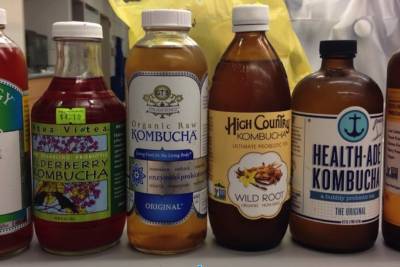
Corner Store: Specialty Item
- Kombucha starter culture, which can come from any of the following:
- Order a culture from an online site e.g. Etsy.com
- Get a culture from a friend (email RockEDU 😉)
- Use the last inch of a store-bought bottle that you like
Preparing the liquid media
- Clean and ideally sanitize equipment (e.g. dishwasher or chemical sanitizer—bleach, StarSan, etc.)
- Brewing Container: 1 L container e.g. pyrex beaker, wide mouth ball jar, or measuring cup
- Spoons (2; one for sugar, one for stirring tea)
- Thermometer
- Storage Container (size depends on how much broth will be left over e.g. the difference between the volume of your storage jars and 1 L; container should seal with a lid)
- Heat 1 L water to boiling (e.g. use an electric kettle, pot on the stove, or beaker on a hot plate)
- Pour ~850 ml of water into the Brewing Container. Let cool to 170F.
- Add 3 bags of green (or black) tea (~6g tea) and let steep for 10 minutes.
- Tug on bags 10 times to disperse the brewed tea. Discard tea bags.
- Add 150 g sucrose (table sugar; ¾ C) and stir until dissolved.
- Bring the water up to 1 L with the excess boiled water.
- Cool to room temperature (in a fridge (~30 min), freezer (keep a close eye on it), or on the counter overnight)
- Label the brewed tea/sugar mixture, and use to start your kombucha culture.
- Note: this is a good stopping point as the sugar-tea can be stored for several weeks in a sealed container if good sanitation was followed.
What experimental question do you have in terms of how something might affect the production and composition of kombucha?
How will you test this?
Splitting your culture
- Clean and ideally sanitize equipment (e.g. dishwasher or chemical sanitizer—bleach, StarSan, etc.)
- Culture jars (as many as you want; 1 is sufficient, but more if you want to have more versions of your culture or more to play around with; containers should be “breathable” e.g. can be covered with cheesecloth, loose covers, petri dishes, etc.)
- Glassware or measuring spoon for transferring existing culture, if needed (or use sterilized plastic e.g. a pipette)
- Pour in your room temperature liquid sugar-tea media (prepared above) to fill the jar ~¾ full (e.g. for a 4 oz mason jar we add 50 – 80 ml of liquid culture)
- Transfer some liquid media from below the solid SCOBY into your jar at 10% of the liquid media volume (e.g. for 50 ml add 5 ml culture; for 80 ml add 8 ml culture)
- Cover in a breathable way (cheesecloth, not-tight-fitting lid, etc.) and let sit for 2 weeks.
- For a negative control, you should also prepare a culture jar but add no culture (just fresh media) so that you can control for contamination of the medium over time—not necessary for just keeping your culture alive, though
Remaining culture after splitting can be bottled and drunk (if using a non-lab ferment) following any number of recipes you can find online.
OR
It can be stored at 4 C/fridge temperature for months as a back-up culture.
OR
To discard, add bleach to 10% final concentration, let sit, and then pour down the drain with plenty of water. Any bleached solid SCOBY can be thrown away in the trash (wear gloves!).
How are the original culture and new cultures related? How is each new jar of culture related to each other?
Would you expect variations to arise between jars? Why or why not?

